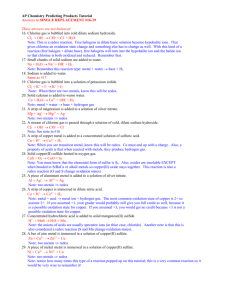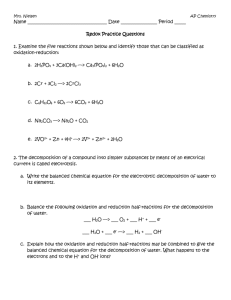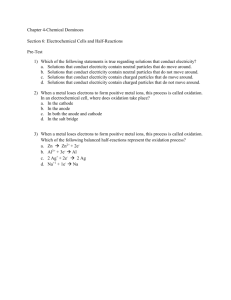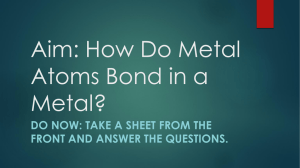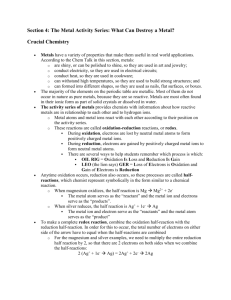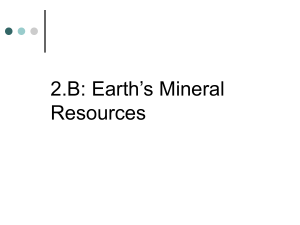Term planner - GaryTurnerScience
advertisement
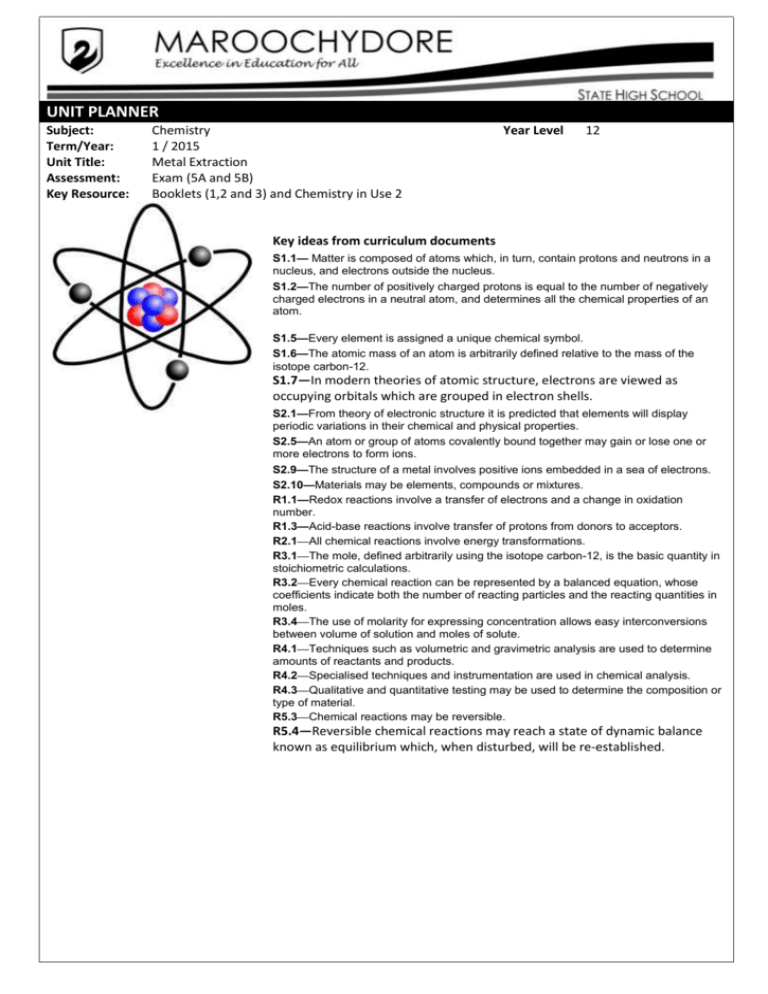
UNIT PLANNER Subject: Term/Year: Unit Title: Assessment: Key Resource: Chemistry 1 / 2015 Metal Extraction Exam (5A and 5B) Booklets (1,2 and 3) and Chemistry in Use 2 Year Level 12 Key ideas from curriculum documents S1.1— Matter is composed of atoms which, in turn, contain protons and neutrons in a nucleus, and electrons outside the nucleus. S1.2—The number of positively charged protons is equal to the number of negatively charged electrons in a neutral atom, and determines all the chemical properties of an atom. S1.5—Every element is assigned a unique chemical symbol. S1.6—The atomic mass of an atom is arbitrarily defined relative to the mass of the isotope carbon-12. S1.7—In modern theories of atomic structure, electrons are viewed as occupying orbitals which are grouped in electron shells. S2.1—From theory of electronic structure it is predicted that elements will display periodic variations in their chemical and physical properties. S2.5—An atom or group of atoms covalently bound together may gain or lose one or more electrons to form ions. S2.9—The structure of a metal involves positive ions embedded in a sea of electrons. S2.10—Materials may be elements, compounds or mixtures. R1.1—Redox reactions involve a transfer of electrons and a change in oxidation number. R1.3—Acid-base reactions involve transfer of protons from donors to acceptors. R2.1—All chemical reactions involve energy transformations. R3.1—The mole, defined arbitrarily using the isotope carbon-12, is the basic quantity in stoichiometric calculations. R3.2—Every chemical reaction can be represented by a balanced equation, whose coefficients indicate both the number of reacting particles and the reacting quantities in moles. R3.4—The use of molarity for expressing concentration allows easy interconversions between volume of solution and moles of solute. R4.1—Techniques such as volumetric and gravimetric analysis are used to determine amounts of reactants and products. R4.2—Specialised techniques and instrumentation are used in chemical analysis. R4.3—Qualitative and quantitative testing may be used to determine the composition or type of material. R5.3—Chemical reactions may be reversible. R5.4—Reversible chemical reactions may reach a state of dynamic balance known as equilibrium which, when disturbed, will be re-established. KEY REQUIREMENTS LITERACY Literacy • Comprehending text through listening, viewing and reading • Composing texts through speaking, writing and creating • Text knowledge • Word knowledge • Visual knowledge NUMERACY • • • • • • Calculating and estimating Recognising and using patterns and relationships Using fractions, decimals, percentages, ratios and rates Using spatial relationships Interpreting and drawing conclusions from statistical information Using measurement ICTs • Inquiring with ICT • Operating ICT CRITICAL & CREATIVE THINKING • • • • Inquiring - identifying, exploring and clarifying information Generating innovative ideas and possibilities Reflecting on thinking, actions and processes Analysing, evaluating and synthesising information DIFFERENTIATION Students requiring support can… The learning experiences within this unit can be differentiated by increasing: • the frequency of exposure for some students • the intensity of teaching by adjusting the group size • the duration needed to complete tasks and assessment. For guided and/or independent practice tasks: • student groupings will offer tasks with a range of complexities to cater for individual learning needs • rotational groupings allow for more or less scaffolding of student learning. Students requiring extension can… The learning experiences within this unit can be differentiated by increasing: • the frequency of exposure for some students • the intensity of teaching by adjusting the group size • the duration needed to complete tasks and assessment. For guided and/or independent practice tasks: • student groupings will offer tasks with a range of complexities to cater for individual learning needs • rotational groupings allow for more or less scaffolding of student learning. CHEMISTRY Metal Extraction WK 1 Wk. Beg 26Jan-15 Term 1 Lesson 1 Lesson 2 -trends(electron config., ionisation energy, electronegativity) The importance of metals to us.(PMI) Why metals are used for various applications Elicit why some metals are more reactive than others Develop the activity series Define redox (oxidation,reduction,oxidising and reducing agent,half reactions Assign oxidation numbers Balance equations using oxidation numbers Review and Consolidate Using metals to make electricity(batteries) Define galvanic cells, anode, cathode, electrolyte, salt bridge, Standard electrode potential 2-Feb15 3 9-Feb15 4 16Feb15 Review and Consolidate Define electrolytic cells and related terminology Student experiment 5 23Feb15 Student experiment: Anodising aluminium Cleaning silver 6 2Mar15 9 10 Review and Consolidate Construct galvanic cells 9Mar15 23Mar15 30Mar15 Critical Learning Lesson Lesson 3 What is a metal? (Compare to non metal) -periodic table 2 7/8 2015 METAL EXTRACTION Origin of metals- natural,ores (names), history of metals Set up copper leaching experiment (day 1) Copper leaching – take sample 1 and repeat Copper leaching – take sample 2 and repeat Copper leaching – take sample 4 and repeat Copper leaching analysis - Spectroscopy Copper leaching – take sample 3 and repeat Preparation for Stimulus Response Question AND Exam Literacy Focus BLOCK EXAMS --- 2 CHEMISTRY EXAMS Numeracy Focus ICT lesson Creative Thinking Practical Lesson Key Words Metals Oxidant Anode Electrode potential Activity series Reductant Cathode Electrolysis Oxidation Half cells Electrodes Ores Reduction Half reactions Electrolyte Leaching Redox Galvanic cells Salt bridge Spectroscopy

